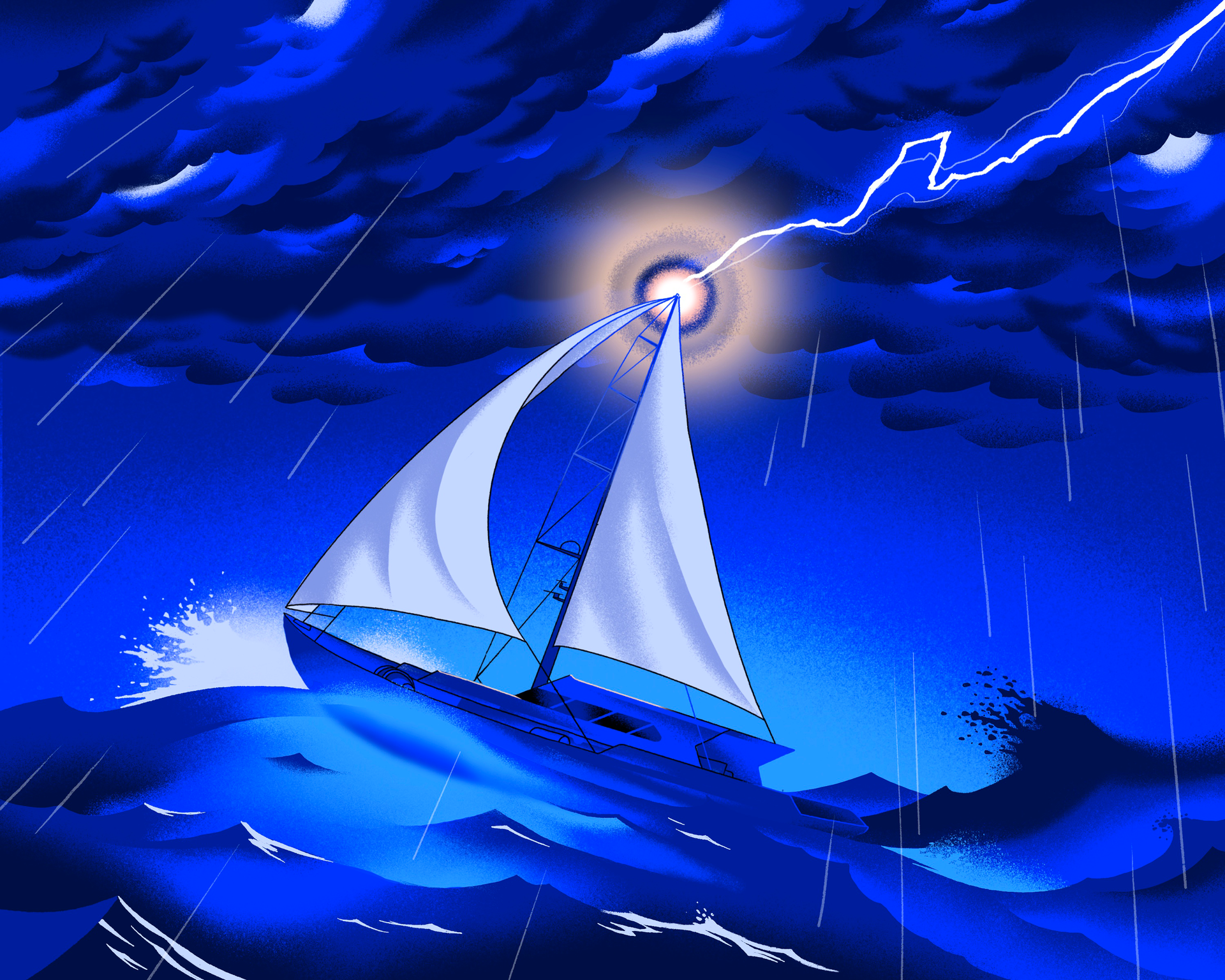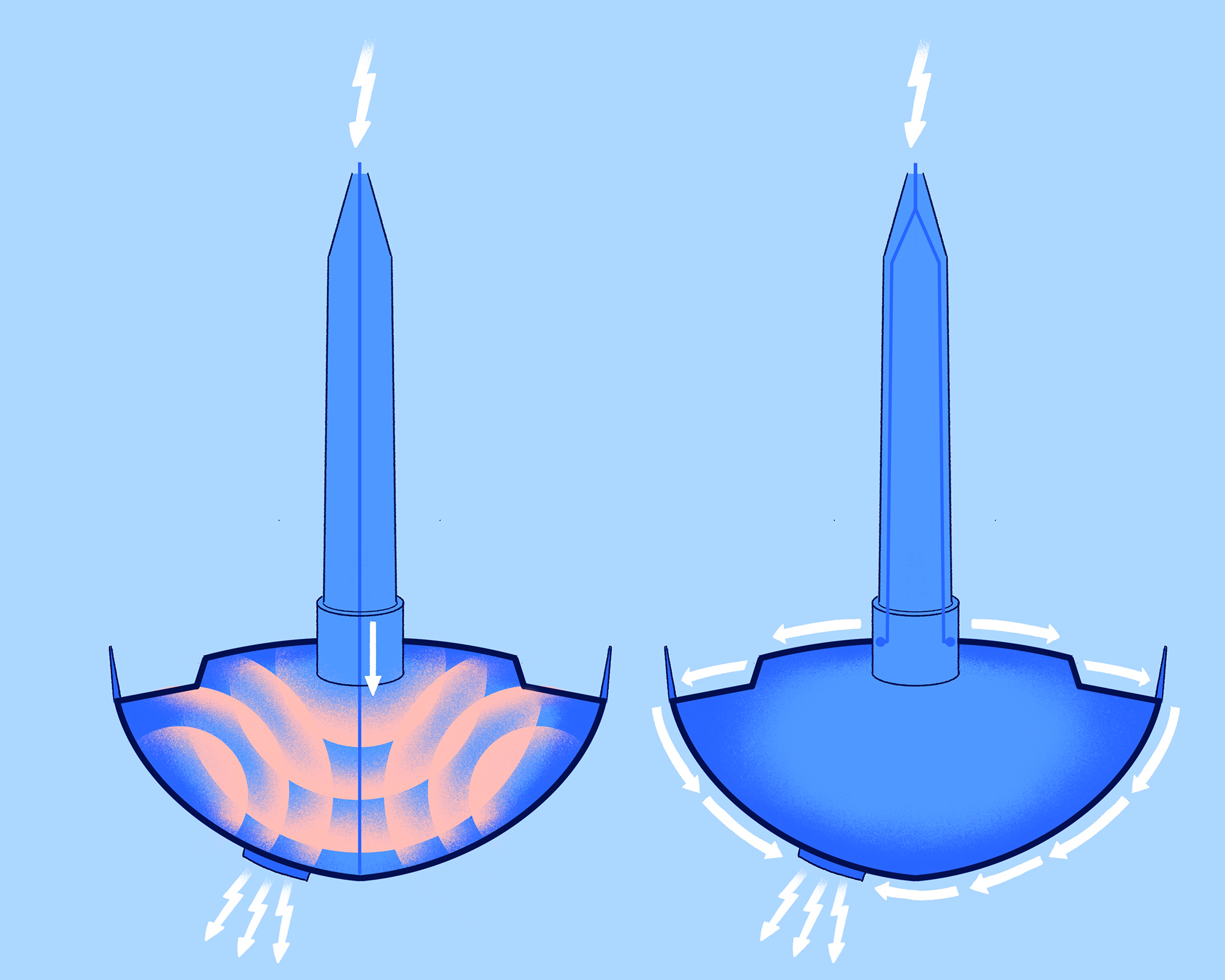Protecting electric yachts from lightning strikes

Lightning strikes are a well-known factor in the maritime industry — and for most vessels aren’t much of a concern. Humans have been dealing with them as long as they've had boats, meaning mature safeguards exist.
Yet, as advancement happens, unexpected consequences occur.
With the world shifting away from fossil fuels, seafaring vessels are relying more and more on electrical power and, in this instance, lightning strikes can become a real problem, potentially wiping out the electronics onboard.
For Sailing Yacht Zero, a vessel powered by renewable energy, this required serious attention. Because of its use of complex electric motors, systems, and data, the team had to take a new approach to protecting the yacht from lightning strikes.
Along the way, they had to take a new approach to the system, one where they had to challenge and redefine industry standards. This is the story of their journey and this advance.
Lightning strikes and seafaring
Any sort of sailboat with a tall mast attracts lightning.
The phenomenon is caused when there’s a charge difference between a cloud and the surface of the earth. In these situations, the cloud wants to discharge itself towards the surface. While on the ocean, the mast of a ship is usually the highest point, which attracts strikes.
While there are a variety of methods to protect boats from the effect of a lightning strike — including some dissipator systems that claim to deter it altogether — one of the most common on yachts involves a rod. Located at the top of a mast, this is an intentional point for the lightning to strike. This then channels the charge down the mast and out the bottom of the ship to a grounding location, regularly a plate underneath the waterline.
At this point, the charge is dispersed into the water. This method has worked effectively for decades, but for electric vessels there’s an issue: the electromagnetic pulse.
Issues with the EMP
Bob van Someren is a physicist who works on Sailing Yacht Zero.
“Because the entire ship is electric, we want to protect it properly,” he says. To achieve this, they began analysing what happens when lightning strikes.
A lightning strike is often between 20 to 200 kiloampere (kA), sometimes even reaching 300 kA, whereas the average is around 30 kA. That’s a lot of variability. The voltage, on the other hand, can range between 100 million to one billion volts. This is a large amount of power, but one that only lasts for 10 to 20 microseconds.

Because it’s a short burst of high voltage, the amount of energy isn’t huge, potentially several hundreds of kilowatt hours (kWh). A large part of this energy is dissipated in the lightning bolt (the “visual” part of the strike). Roughly 95 % of the strike’s energy is in the flash and thunder.
“The lightning protection system itself, as we designed it, has to deal with far less energy, specifically in the range of a few kWh,” says Van Someren.
The issue isn’t the energy itself but the short duration, high current pulse.
“This high current pulse gives a very big electromagnetic pulse (EMP),” van Someren says, “and that’s usually what damages your electronics. That’s our problem.”
At first, the team behind Sailing Yacht Zero looked into lightning protection systems, such as surge protectors and electromagnetic interference filters. The former clamps high voltages caused by lightning-induced surges to a safe level, while the latter can suppress the electromagnetic fields created after a strike.
Unfortunately, while useful, these sorts of on-market suppression systems didn’t fully convince the team behind Sailing Yacht Zero.
“The risk for our ship is too great to depend on them completely,” says van Someren.
Solving this meant going back to the drawing board and finding a new way of protecting an electric yacht from lightning strikes.
A new way of looking at an old problem
Eduard van Benthem, the project manager of Sailing Yacht Zero, explains that the team discussed various options, but focused specifically on what happens when lightning actually strikes a vessel.
It was at this point the topic of a Faraday cage arose during a brainstorming session.
A Faraday cage is when electricity flows on the outside of a conductor, stopping any external electric fields from penetrating the inside. Think of it like sitting in a tent during a storm. If the frames are hit by lightning while you’re inside, the electricity remains external, keeping you safe.
In this case, it’s the electricity that’s dangerous to humans. For yachts, it’s EMPs. Electronics contain conductors and EMPs generate voltage spikes in those conductors, which can damage them. But the intriguing part of a Faraday cage is it stops both electricity and EMPs from penetrating the inside.
“The industry standard,” van Benthem explains, “is that the Faraday cage is compromised when a boat is hit by lightning because you put the cable running the lightning charge straight through the inside of the boat.”
In other words, because many yachts channel the charge from a lightning strike through the ship itself to a discharging plate at the base, an electromagnetic field is excited inside the vessel. This is caused by the considerable current pulse in the cable.
A Faraday cage is a solution to this.
Sailing Yacht Zero’s vessel’s hull is made from aluminium, a good conductor. If current travels along the surface of the hull, van Benthem says it “basically that means that all the electronics inside the hull are inside the Faraday cage” and the bulk of the electromagnetic pulse won’t penetrate the structure of the yacht and damage sensitive equipment.
Van Benthem sums it up as such: “We're putting a spike on top of the mast, a metal rod that’s the highest point of the ship. This spike will be connected to the lightning cable which needs to have a serious amount of surface area. If the rod gets struck by lightning, it conducts the current down through a cable.”
Rather than running the cable through the hull, which is the more standard way on yachts, this vessel will connect it to the outside. Specifically, at the point where the mast enters the boat. This means the current is conducted along the hull, and the EMP produced by the strike stays away from Sailing Yacht Zero’s sensitive innards.

The theory was solid, had passed analysis and calculations, and was validated with a variety of industry experts, all the way from insurers to figures in the aviation industry. But the next step? That was turning this idea into reality.
Moving from theory to practice
The key element in channeling the lightning strike to the outside of the hull was the mast. Rather than the cable carrying the current going straight through the middle, it needed to exit the mast just above the decking.
For this, the team behind Sailing Yacht Zero spoke with Carbo-Link, a company it was collaborating with on a brand-new mast ventilation system, the mast itself, the rigging, and more.
Headquartered just outside of Zurich, Carbo-Link is an advanced composite manufacturing business. It uses a combination of material science, design, and engineering to solve structural issues for a huge swathe of sectors.
To find out how they approached incorporating this system into a mast, we spoke with Edoardo Volpe, the mast division development engineer at Carbo-Link who is coordinating the engineering process on this project.
“This is an absolute first,” says Volpe, “no one dared to try to guide the lightning strike outside and not into the boat.”
The top of the mast, Volpe explains, is quite traditional, with a lightning spike on top in order to attract the lightning. Where the real engineering came though is where the cable carrying the current exits the mast.
“The exit is just above the deck,” Volpe says, “and that’s probably the most stressful area for the mast.”
This led to a unique challenge: for the lightning system to work, the cable running the charge needed to come out at a part of the mast that’s under a huge amount of stress. Thankfully, this is the sort of challenge that Carbo-Link relishes.
“First we investigated the best part of the circumference of the mast where the stress would be least,” says Volpe. They ran an array of simulations to discover where there were fewer relative forces coming through. They screened several locations before settling on where to put the exit location for the cable.
And after this? “We simulate the cutout to recalculate the structural requirements, run the simulation and validate the new structure,” Volpe says.
It’s this level of testing that led to the location of the exit slot for the light surge cable on the base of the mast — but the story’s not through yet.
Figuring out the finer details
There is another issue that the team had to deal with.
Because there are system cables running from Sailing Yacht Zero’s mast into the hull, they can potentially break the Faraday cage by entering its middle. In this instance, van Benthem explains that “we have to minimise the influence of the energy through the lightning cable on the other cables. Where this is not possible we have to install a kind of fuse to block this energy flow.”
This will both interrupt high-current surges and help isolate internal systems from conductive paths that could undermine the Faraday cage.
Of course, there’s a bigger issue at play currently: much of this is theory.
Although as much testing as possible will take place ahead of the sea trials, there are many aspects that simply need to be put into real-world environments and see where potential issues may arise. When this happens at the start of 2026, it will only be a matter of time until the final aspects of this novel approach to lightning protection will be put to the test.
Well, when it’s struck by lightning, of course. Although this will happen at some point, it’s not something that can be scheduled or planned, after all.
The future of lightning protection for the maritime industry
With the entire world moving away from fossil fuels, seafaring vessels are in a state of transition. This means they have to deal with current challenges and standards, but in a manner that’s prepping for a future of more sustainable energy.
As this occurs, there’ll be an array of unexpected consequences, with dealing with lightning strikes among them.
It’s in this shift that the work of innovators in the sector becomes vital. By addressing these concerns before technology becomes widespread, projects like Sailing Yacht Zero can help define and shape the future of the maritime industry.
Lightning strikes are a constant in seafaring, but fossil fuels aren’t — and we need to deal with the former before the latter is left wholly in the past.